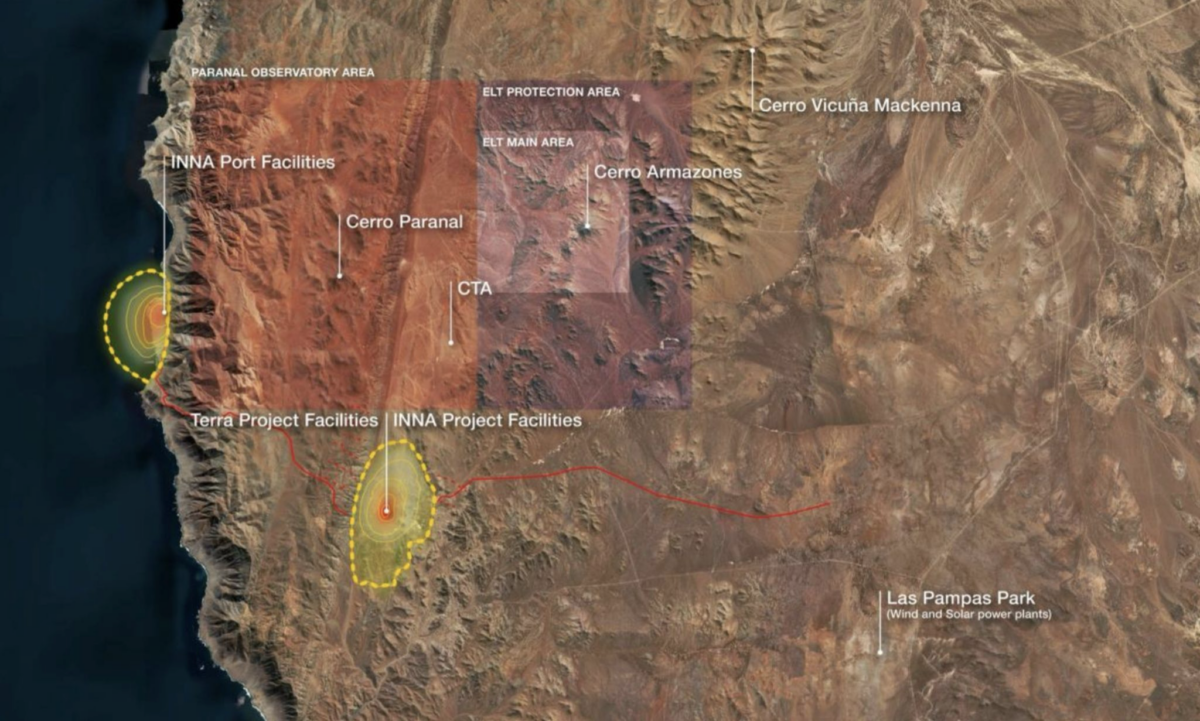The Milky Battle arches overhead on this panoramic view of the darkish sky above ESO’s Very Huge Telescope on the Paranal Observatory in Chile. Credit score: John Colosimo (colosimophotography.com)/ESO
A proposed huge hydrogen-fuel manufacturing venture in Chile has astronomers galvanized in worry and opposition. One astronomer calls the imaginable Chilean facility a “nightmare” for the Paranal Observatory’s darkish skies.
One learn about has discovered that Paranal, positioned in Chile’s Atacama Wilderness, has the darkest skies of any main astronomical analysis website. That may exchange if the plant, referred to as INNA, is constructed.
The proposed venture is a “green hydrogen” facility that might produce hydrogen the usage of renewable power. The hydrogen can be utilized for gas, fertilizer, and different wishes. AES’s web page claims it’s “a critical fuel of the future to reach net-zero as hydrogen demand, adoption of clean technologies and economic opportunity continue to increase.” Building, if licensed, would start in two years, ultimate for 5, with the ability seeing a four-decade operational existence.
The problem of location
Nobody Astronomy spoke to disputes the will for various power resources in a global going through expanding local weather exchange. Relatively, it’s the positioning and scale the AES proposal this is so relating to.
The positioning of the ability might be “if not the worst, one of the most menacing industrial projects to the astronomical activity in Chile,” says Gaspar Galaz, a professor on the Instituto de Astrofísica, Pontificia Universidad Católica de Chile. “The venture … is sort of a tale taken from a nightmare of an astronomer. “
The gas manufacturing amenities, roads, lighting, a desalination plant, and port at the coast would additionally impact the deliberate Cherenkov Telescope Array (CTA), Galaz provides. This array goals to be the primary Southern Hemisphere software to identify ultra-energetic astrophysical phenomena. “In addition, the CTA will detect blue light,” he says, “one of the most affected wavelengths by light pollution and by dust.”
Certainly, the ESO press unencumber emphasised that “dust emissions during construction, increased atmospheric turbulence [from wind turbines], and especially light pollution will irreparably impact the capabilities for astronomical observation, which have thus far attracted multi-billion-Euro investments by the governments of the ESO Member States.”
 This map presentations the positioning of the Paranal Observatory and the ELT building website at Cerro Armazones, in addition to the proposed location of the INNA facility and port. Credit score: Courtesy of Christopher Cokinos
This map presentations the positioning of the Paranal Observatory and the ELT building website at Cerro Armazones, in addition to the proposed location of the INNA facility and port. Credit score: Courtesy of Christopher Cokinos
An pointless selection
ESO Director Normal Xavier Barcons tells Astronomy that “Chile should not have to make a choice between hosting the most powerful astronomical observatories and developing a green hydrogen production plant. Both are declared strategic priorities by the country and are fully compatible. The only and obvious solution is that the … project moves no less than 50 kilometers [31 miles] away from the Paranal Observatory.”
The venture would make analysis of faint fuzzies tricky, most likely inconceivable. Even with instrumentation upgrades and complex generation, provides Barcons, “sky brightness may be actually a stronger limiting factor.”
In keeping with Chilean officers, the venture is below govt assessment and public feedback — together with from ESO and the clinical neighborhood — might be regarded as. The assessment will have to additionally consider federal light-pollution laws.
However Chilean-born Bernardita Ried Guachalla, a physics doctoral pupil at Stanford, believes the light-pollution regulation isn’t sturdy sufficient. “The current regulations regulate the emissions of each project or light source and establishes a 1 percent of light pollution limit, without taking into account the cumulative effect of multiple projects,” she says. As smartly, the foundations “establish a value of 10 percent as an acceptable limit for artificial light pollution. This value would make the Paranal Observatory and its telescopes … practically useless.”
Whilst Galaz says that “the most shocking aspect here is that the Chilean authorities have kept an incredible silence regarding this issue,” ESO has been seeking to paintings with AES and the federal government.
“The Chilean government has set up an inter-ministerial table looking at the challenge and trying to find a solution,” explains Barcons. He notes, on the other hand, that AES has been lower than cooperative. After ESO gave the corporate details about the hydrogen plant’s results and the want to relocate it, AES went forward and “submitted the project placed next to the Paranal territory, therefore ignoring our request.”
AES tells Astronomy the venture’s location in “one of the renewable energy development hubs … aligns with Chile’s National Green Hydrogen Strategy and incorporates the highest standards in lighting in its design.” AES claims that “both the Very Large Telescope (VLT) at Cerro Paranal and the Extremely Large Telescope (ELT) at Cerro Armazones are outside the significant impact area calculated for the project. The observatories are 19.6 km and 29 km [12.2 miles and 18 miles] away from INNA, respectively,” which the corporate says complies with govt laws.
AES additionally says “calculations confirm that the maximum increase over the natural sky brightness is only 0.27 percent at Cerro Paranal and 0.09 percent at Cerro Armazones, both well below the permitted limit, ensuring the protection of these astronomical areas.”
Ried Guachalla questions the distances invoked on this commentary; Galaz says “the distance they point out to the VLT … is wrong.” He additionally says that if AES’s light-pollution claims are right kind, “ESO would not have started officially a complaint … nor the astronomical community in Chile would have started to defend anything.”
Comparable: The battle in opposition to gentle pollutants
Astronomy in Chile
The debate highlights Chile’s distinctive function in fashionable astronomy.
Cosmologist and College of Arizona professor Chris Impey places it this fashion: “Astronomy is a matter to great pride to Chileans. It has brought prestige, billions of dollars of investment, and thousands of jobs to the country. So protecting it would seem to be a priority for the government.”
Daniela González, the chief director of the Fundación Cielos de Chile, a dark-sky coverage group, consents: “Chile currently has more than 40 percent of the world’s astronomical observing capacity, and with the development of the new generation of large telescopes being built in the country, this percentage will increase to almost 70 percent. From this perspective, not only is the quality of the dark skies of northern Chile at stake, but it is also a global issue, where the Chilean State must respond to the international scientific community.” She too needs the venture moved.
“Chile has a tremendous potential for the generation of renewable energies,” she provides, noting that “there are other sites equally suitable to develop the project.” As smartly, she believes proponents of the venture are overselling its financial advantages. “These companies promise significant amounts of investment and jobs, but in practice they never reach the promised figures.”
Ried Guachalla helps to unfold the phrase in regards to the AES danger to Paranal. She says she didn’t take the venture’s penalties as critically as she would possibly have early on, however now broadcasts: “My commitment is with the sky. Everyone should be as concerned as me.” Nonetheless, she urges astronomers the usage of amenities in Chile — particularly the ones coming from out of the country — to do extra public outreach and engagement with a view to higher perceive the rustic, to lift clinical literacy and to achieve allies.
Recently each AES and ESO have legal professionals representing their respective reasons, in line with Ried Guachalla.
Barcons stays emphatic, announcing that “the ELT is the largest optical telescope ever conceived and is being built to scrutinize the deepest and most challenging edges of the universe. It is not a coincidence that the ELT is being erected in the darkest place in the world. We cannot and we should not allow this unparalleled knowledge … to be put out of reach … by degrading the sky at the observing site.”

